
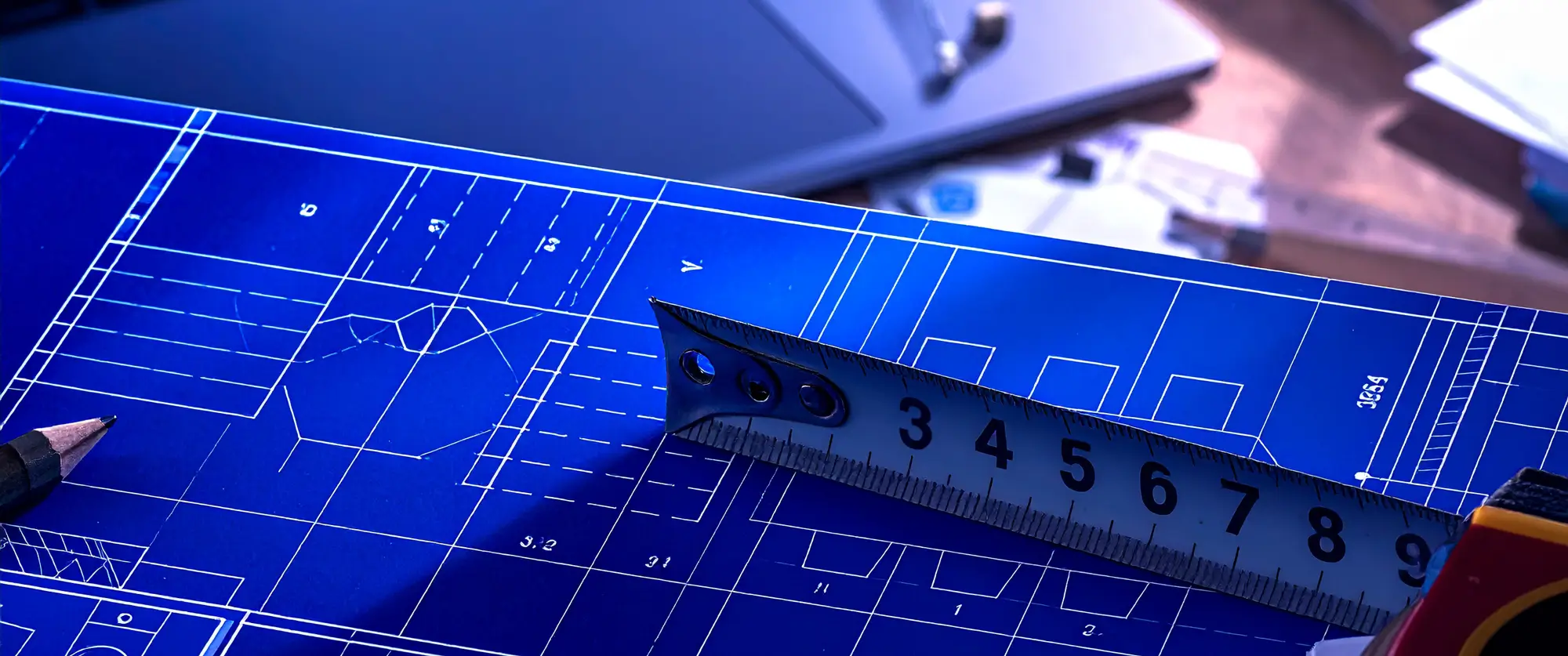
What is a Quantity Takeoff in Construction? Complete Guide
TL;DR: Quantity takeoff is the process of methodically measuring and itemizing all materials, labor, and equipment a construction project will need. This crucial first step keeps cost estimates realistic, helps teams plan resources efficiently, and stops expensive surprises before they start. Master QTO, and you’ll run tighter budgets, submit winning bids, and keep jobs on track from kickoff to closeout.
Introduction to Quantity Takeoff Construction
Every project manager knows the stress: the moment a budget is blown or a last-minute material shortage throws the whole schedule into chaos. In today’s construction industry, where every dollar and day counts, even a small estimating error can trigger long delays or eat into profits. Teams juggle tough bids, complex project scopes, and the challenge of keeping project documents accurate and up to date.
There’s no hiding from it: one wrong number in your quantity takeoff, and suddenly your whole estimate is off, purchasing is disrupted, and crews are left waiting. With so many moving pieces, nailing this stage is both critical and nuanced.
But there is a better way. Modern digital quantity takeoff tools and structured quantity takeoff processes using unified platforms like CostOS give estimators and managers a way to get a handle on the numbers. Centralizing counts, measurements, and documentation isn’t just convenient. It forms the backbone of a well-organized construction project and sets the foundation for a project that’s easier to manage and more likely to hit budget. Let’s walk through how quantity takeoff smooths out your workflow and anchors every solid construction estimate.
What is a Quantity Takeoff in Construction?
Definition and Core Purpose of Quantity Takeoff in the Construction Industry
So, what does quantity takeoff involve? At its core, a quantity takeoff is a systematic process that measures, identifies, and lists all construction materials, labor, equipment, and resources required for a construction project. As ProjectManager puts it, QTO builds a full inventory based on your construction drawings and project specifications. We're not just counting pipes or beams—we’re making sure nothing gets missed when it’s time to plan the build.
A complete quantity takeoff includes a list of all physical materials necessary to complete a job and their costs, making it integral to the cost estimation process. Detailed quantity takeoffs provide a breakdown of materials required, help track construction costs, and are critical for producing accurate cost estimation and budgeting during construction.
But QTO isn’t just about extracting numbers. It arms engineers, estimators, and managers with a clear way to turn design documents into actionable lists for real-world jobs. AlSyed Construction highlights how this process is the gateway to trustworthy cost estimates and realistic schedules. Accurate quantity takeoff is essential for producing precise estimates that guide budgeting and planning. Without accurate quantity takeoffs, construction projects can suffer from budget overruns and unexpected expenses.
Learning how to conduct a quantity takeoff is a vital skill in the construction industry. The type of data collected and the quality of analysis can significantly impact a project and contribute to its successful organization and execution.
For teams ready to step up their process, cost estimating software can bring new structure, accuracy, and efficiency by making digital quantity takeoff faster, more precise, and collaborative.
Why Quantity Takeoff Matters in Construction Projects
Getting the quantity takeoff process right isn’t just another task. It’s make-or-break for staying on budget and on schedule within any construction project. Thorough takeoffs lead to realistic cost estimates, nipping those mid-project budget shocks in the bud. As ProjectManager says, if your quantities are off, you’re running on hope, not a plan.
Accurate quantity takeoffs provide the detailed material breakdowns that every construction project relies on. They benefit a project by enabling clear communication with clients and stakeholders about construction costs, reducing material waste, and managing resources efficiently.
The Role of Accurate Quantity Takeoff in Planning
Quantity takeoffs reflect an important part of planning in construction projects by providing precise quantity data about materials needed, labor costs, and equipment for every project phase. When done with attention to detail, they serve as a baseline to evaluate design changes’ impact on budgets and overall project components. Projects grounded in accurate quantity takeoffs run with fewer surprises and delays, supporting project success.
Quantity takeoff allows for effective project planning: teams can build budgets off real quantities, not ballpark guesses, and time purchases and deliveries to fit the construction schedule. These practices minimize errors, reduce the risk of budget overruns, and support successful procurement management in construction.
Quantity Takeoff’s Value for Construction Estimating
Quantity takeoffs are critical for effective cost estimation. They enable reliable cost estimates that drive budgeting, procurement, and scheduling. They help anticipate unexpected expenses and enable project managers to have real control from day one. When accurate construction takeoffs are produced, bids are tighter, change orders are fewer, and construction projects enjoy more predictable outcomes.
Accurate quantity takeoffs also enhance productivity in construction by minimizing costly errors and helping to track construction costs, which aids ongoing decision-making and budget management.
How Quantity Takeoff Fits into the Construction Project Process
Quantity takeoff is the translator between blueprints and reality. It takes construction drawings and models and turns them into clear, usable numbers so everyone—from estimator to site manager—knows exactly what’s needed. When you see how quantity takeoff weaves into every phase, you understand why it’s so central to any construction project’s success.
Key Stages Utilizing Quantity Takeoff
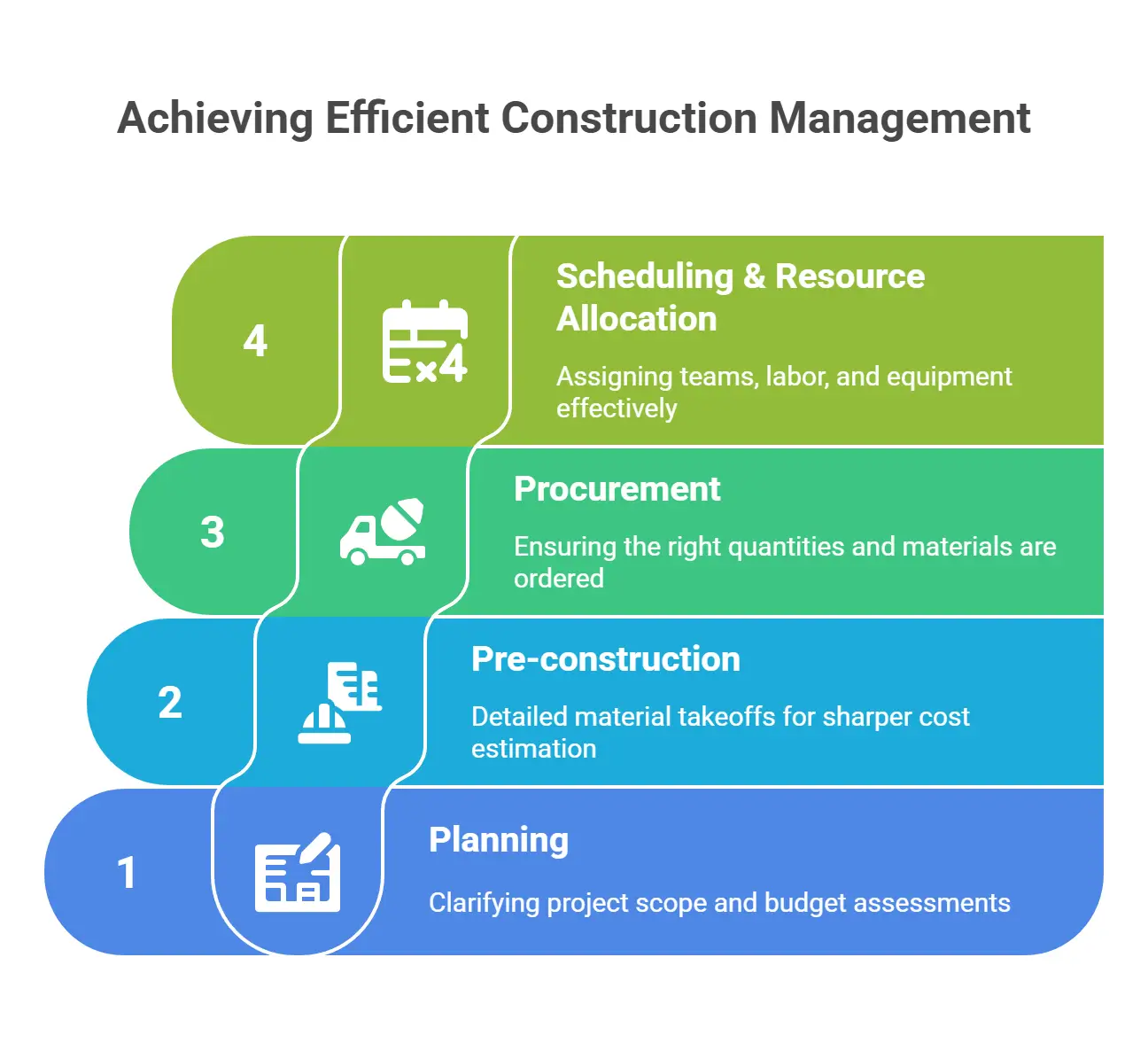
Quantity takeoff isn’t a one-and-done step. It appears throughout the construction process, supporting several stages of every building project:
- Planning: Clarifies project scope and provides early budget assessments, listing all materials needed for the job.
- Pre-construction phase: As designs solidify, more detailed material takeoffs and quantity takeoffs allow for sharper cost estimation and tighter schedules.
- Procurement: Precise quantity data ensures the right quantities and materials required are ordered, preventing shortages or overstock and supporting timely deliveries.
- Scheduling & Resource Allocation: Construction estimating depends on these figures to assign teams, labor, and equipment, ensuring each resource is in place as needed.
Quantity takeoff keeps the entire construction chain connected—from managers to buyers to field crews. Digital solutions like Nomitech’s enterprise estimating suite make these workflows even more efficient.
Role in the Bidding and Cost Estimation Process
Quantity takeoff sets the stage for a successful bid. MT Copeland explains that quantity takeoff is the pulse check, showing what the job actually requires, not just what’s drawn in the project documents.
Contractors and subcontractors use quantity takeoff to break down the full scope before pricing a project. Bids anchored in reliable material takeoff and labor costs help win contracts and protect against budget overruns.
Worth noting: Quantity takeoff is about pinning down exactly what’s needed and the quantities involved. Costs come afterward in the cost estimation process.
Types, Methods, and Components of Quantity Takeoff
For accurate cost estimation, you need to understand what a quantity takeoff includes and the methods available. The right approach streamlines project documentation, supports project efficiency, and enables accurate quantity takeoffs for any construction project.
Components of a Quantity Takeoff in Construction
A reliable quantity takeoff breaks the project into these key project components:
- Materials: All construction materials required, including concrete, bricks, steel, fixtures, light fixtures, roofing materials, and finishing products. The process involves detailed review of construction drawings to identify unit count, linear length, surface area, and cubic volume as appropriate for each item.
- Labor: Accounting for general and specialized labor costs, including supervisors and crews needed for every phase of the construction project.
- Equipment: Every piece, from heavy machinery to tools, is included and scheduled so nothing is overlooked.
A well-executed QTO with detailed estimates ensures all physical materials needed are identified, which streamlines procurement and supports planning.
QTO vs. Material Takeoff
"Quantity Takeoff" and "Material Takeoff" are often confused, but the distinction is important:
- Quantity Takeoff (QTO): A comprehensive enumeration of all resources—materials, labor, and equipment—required for a construction project. Referenced by Kreo, QTO encompasses precise measurements including unit count, linear length, surface area, and cubic volume when quantifying each aspect.
- Material Takeoff: Focused specifically on construction materials. It’s used primarily for procurement actions, calculating how much material by type (like steel, electrical wiring, fixtures) must be purchased. It does not account for labor or equipment needs.
Both material quantity takeoff and comprehensive quantity takeoff have their place in a construction project. Accurate material takeoffs benefit procurement, but only full quantity takeoffs enable correct budgeting and overall cost control.
Alternative Terminologies in Construction Takeoff
Other terms in the construction industry may overlap or be used interchangeably:
- Construction Takeoff: Can refer to either material or quantity takeoff and is often the first step in construction estimating.
- Bill of Quantities: Used primarily in the UK, this gathers all takeoff data for use throughout the construction project.
- Material Takeoff: List of construction materials only.
- Quantity Takeoff: All-encompassing, covers labor, materials, and equipment for accurate cost estimation.
Quantity Takeoff Methods: Manual vs. Digital Takeoffs
Manual Quantity Takeoff
Manual takeoffs rely on the estimator’s skills to interpret construction drawings, project plans, and specifications. This method is time-consuming and prone to human error, but sometimes serves as a valuable double-check for digital methods when discrepancies arise. Attention to detail is paramount to avoid mistakes in scaling or measurement that can impact the entire construction process.
Digital Quantity Takeoff
Digital quantity takeoff utilizes specialized takeoff software to automate calculations, increase speed, and reduce human error. Digital takeoff software enables teams to centralize project documentation, track exact quantities, and collaborate in real time, enhancing project efficiency and reducing administrative time. BIM technology stands out for automating extraction of quantities directly from 3D models, greatly improving estimation accuracy.
Both manual and digital methods require attention to project specifications and site conditions to ensure accuracy. Proper training and proficiency in software significantly reduce the risk of mistakes.
The Step-by-Step Construction Takeoff Process
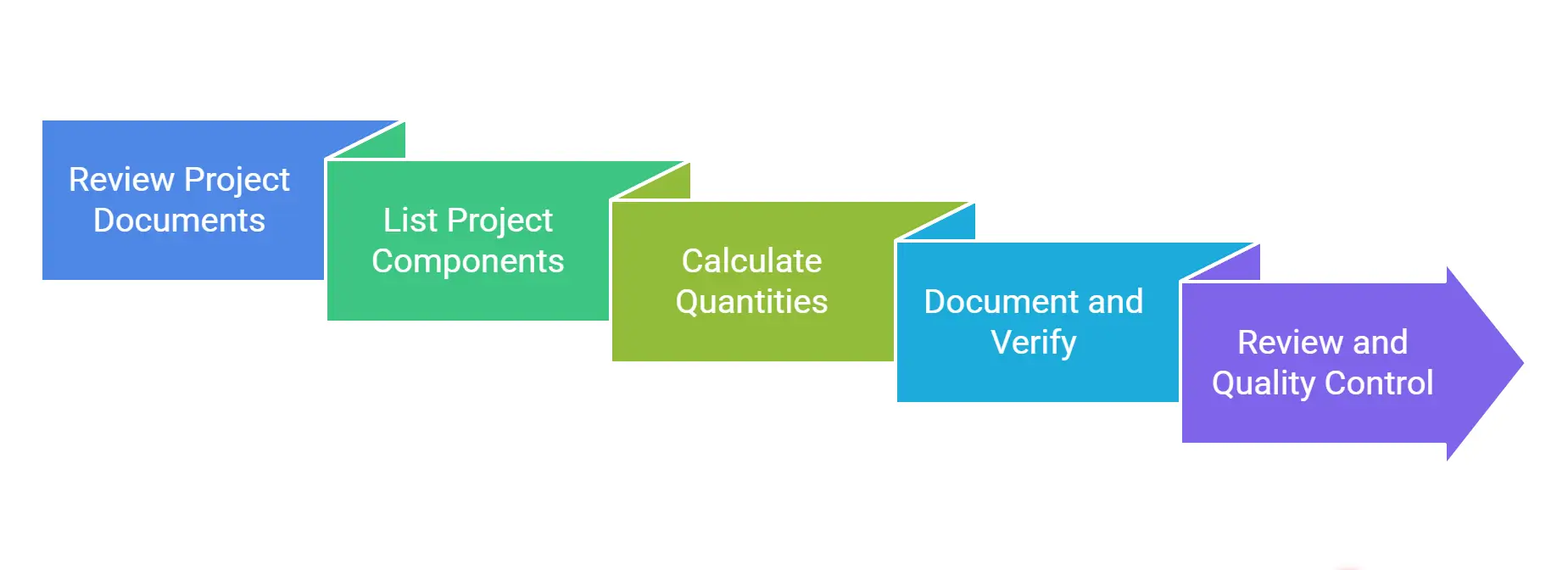
A solid construction takeoff doesn’t happen by accident. It requires following a careful sequence to ensure accurate quantity takeoffs and precise cost estimation that the entire construction team can stand behind.
1. Reviewing Project Documents and Construction Drawings
Begin with a thorough review of project documents, including construction drawings and specifications. Prime Estimation notes that missing a single item or mistakenly interpreting the specs can lead to costly errors.
Drawings provide all the critical dimensions and details needed to calculate quantities, such as length, surface area, cubic volume, and more. Modern BIM takeoff software can extract much of this data, making digital quantity takeoff the preferred method for complex projects.
2. Listing and Quantifying Project Components
Create a master checklist of all materials required, labor, and equipment, noting the type, size, and unit for each. Use linear length for items like beams or piping, surface area for finishes, and cubic volume for concrete pours. This list forms the foundation for further cost estimation and project planning.
3. Calculating Quantities for Accurate Cost Estimation
Assign the proper unit of measurement and calculate exact quantities. Double-check your math to guard against mistakes. If you’re working with material takeoff, focus specifically on quantities for procurement; for full construction estimating, ensure labor and equipment are accounted for too.
4. Documentation and Verification
Document where each measurement came from on the construction drawings, record any assumptions, and include a detailed breakdown with cost estimates. Independent takeoff professionals or quantity surveyors can be retained to review and validate results.
5. Review and Quality Control
Quality control is essential to minimize human error and ensure effective quantity takeoff. Use checklists, peer reviews, and senior estimation sign-offs. Establish a quality control system such as a standardized verification process for all takeoffs.
Stakeholders in the Quantity Takeoff Process
Successful quantity takeoff in construction projects is a team effort, involving multiple stakeholders:
- Engineers provide specs and plans for material requirements.
- Estimators calculate quantities and costs for accurate estimation.
- Quantity surveyors specialize in material estimates and handle detailed material takeoffs.
- Project managers oversee the takeoff process to ensure alignment with project budgets and timelines.
- Contractors and subcontractors conduct quantity takeoff and material takeoff to prepare bids and estimate project costs.
- Architects contribute expertise for accurate material takeoff.
- Independent professionals may review takeoffs to ensure accuracy.
All staff involved in front-end planning need to coordinate throughout the quantity takeoff process to enhance accuracy and reduce risk of missed or duplicated quantities.
Technology's Role: Digital Quantity Takeoff and Takeoff Software
Advantages of Digital Tools in Quantity Takeoff Construction
Digital quantity takeoff is transforming the construction industry, offering new levels of speed, precision, and team collaboration. Use of takeoff software and BIM is widely recognized for delivering faster estimates, improved project documentation, and reduced risk of human error.
Key benefits include:
- Speed: Digital takeoff software automates calculations and quickly updates estimates when designs change.
- Accuracy: BIM technology and advanced software extract quantities from 3D models, supporting precise quantity takeoffs.
- Collaboration: Centralized, real-time access ensures all stakeholders are working with up-to-date information, facilitating project management and reducing delays.
- Scenario Planning: Instantly see the impact of scope changes or cost increases.
- Integration: Modern tools directly connect with construction estimating and project management platforms, supporting the entire construction chain.
Digital methods are especially vital for complex projects, where manual quantity takeoff would consume valuable time and increase exposure to mistakes.
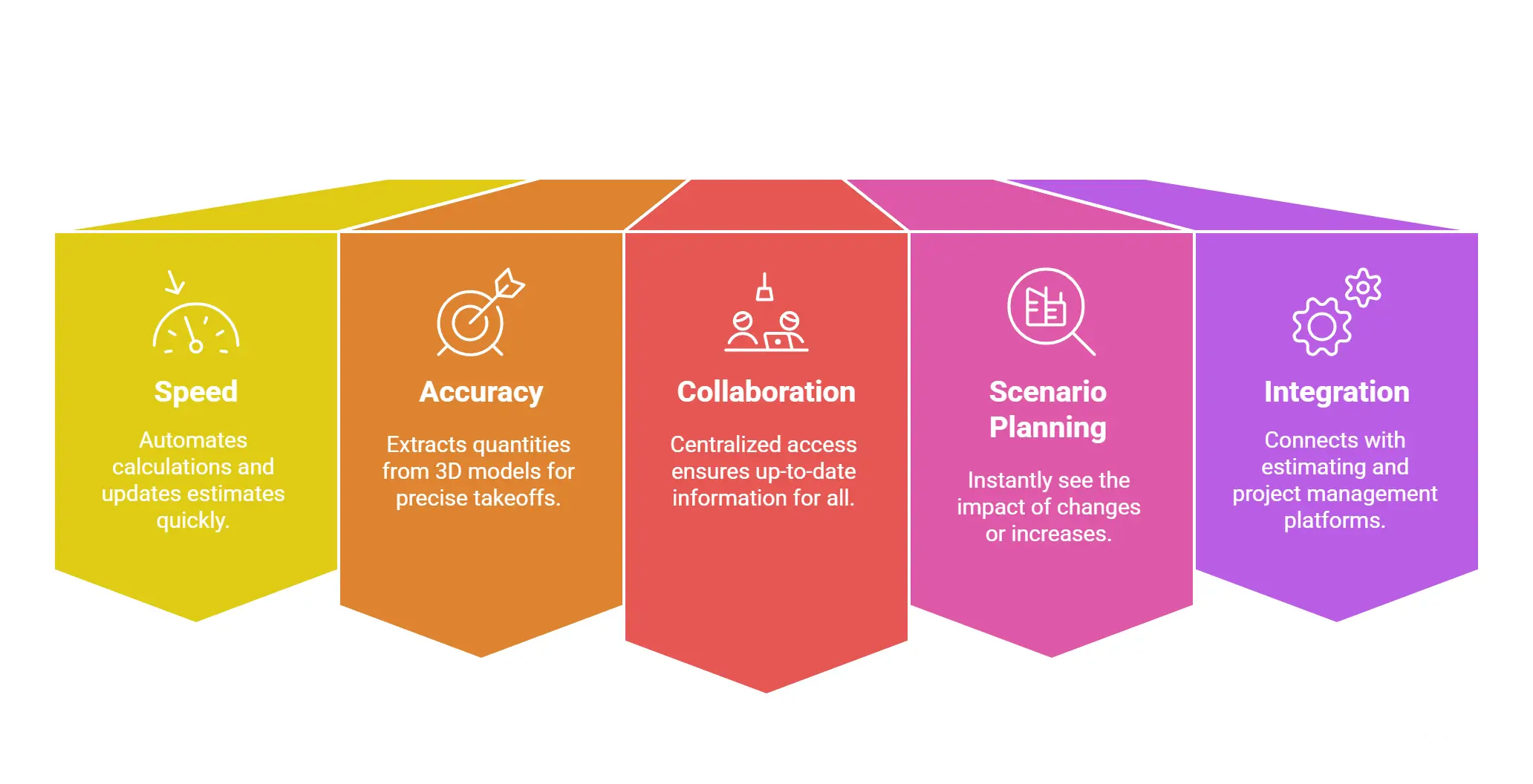
Manual Takeoffs vs. Digital Takeoffs
While digital quantity takeoff is now industry standard, manual takeoffs are still used to double-check results or in small-scale projects. Manual methods rely heavily on estimator expertise but are time-consuming and more likely to result in mistakes due to human error. Combining both manual and digital approaches provides the highest level of accuracy for vital projects and helps organizations avoid budget overruns or project delays.
Best Practices for Ensuring Accurate Quantity Takeoff Construction
Quantity takeoff accuracy is the guardrail keeping your project out of trouble. It’s not just about catching typos, but about creating a repeatable, standardized takeoff process where trusted estimates are the norm, not the exception.
Consistent Review and Verification
Always check your own measurements after initial takeoff. Pass the results to a peer or another estimator for independent validation and have a senior estimator or project manager sign off. Reviewing every construction drawing, regardless of size, is crucial.
A standardized review checklist might include:
- Examination of all relevant project documentation and drawing sheets
- Verifying materials needed and measured match actual plans and specifications
- Checking calculations for errors or inconsistencies
- Using cost benchmarking tools to compare with similar past projects
Independent professionals can be retained for further review in large-scale or high-value projects.
Adopting Standardized Measurements and Documentation
Consistency across quantity takeoff methods makes reviews easier and estimates more reliable:
- Use the same units consistently (length, area, cubic volume) and document every assumption.
- Build templates for frequent construction components (such as light fixtures, steel beams, roofing materials).
- Document the source location for each measurement and any project-specific conditions that affect quantities.
- Note how measurements relate to labor costs and transportation costs during the estimation process.
This transparent documentation ensures two estimators reviewing the same project reach the same conclusion, turning takeoff from a guessing game to an audit-friendly, dependable system.
Minimizing Errors and Ensuring Project Success
Major challenges in quantity takeoff include:
- Mistakes from lack of attention to detail or rushing through measurements.
- Failure to update takeoffs as designs evolve, resulting in outdated or incorrect material quantities.
- Skipping review of specifications and site conditions, leading to overlooked materials or rework.
- Lack of team collaboration, which can duplicate or omit critical items.
To overcome these, invest in staff training, use robust takeoff software, set up quality control systems, and promote collaboration among different trades.
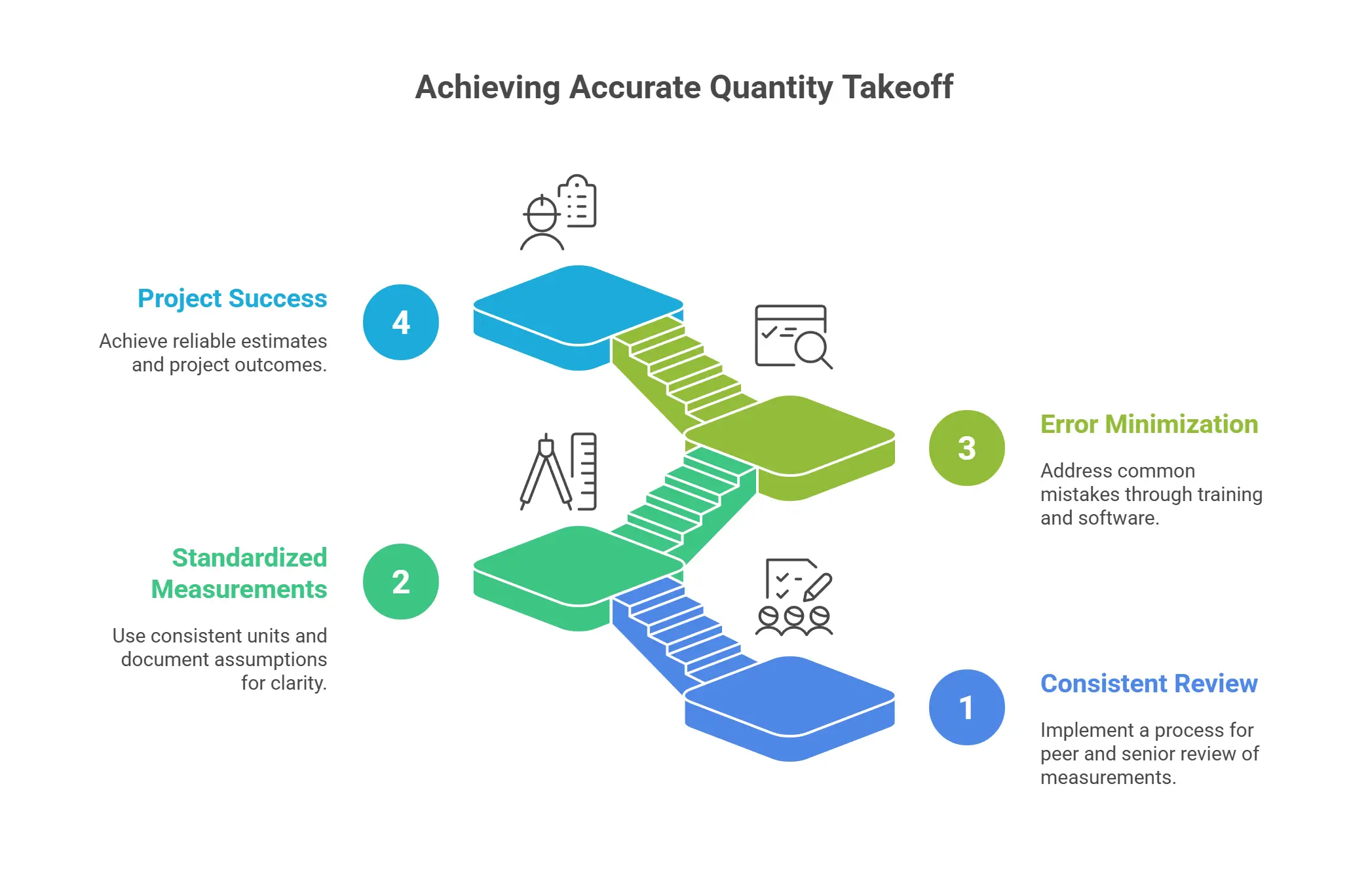
Benefits of Accurate Quantity Takeoffs for Construction Projects
Accurate quantity takeoffs contribute directly to improved project outcomes in the construction industry:
- Enable better project planning and efficiency by ensuring materials required are sourced on time and in exact quantities.
- Provide reliable cost estimates, serving as the base for cost control and proactive budget management.
- Enhance communication and coordination among stakeholders, minimizing errors and improving overall productivity.
- Reduce risk of budget overruns and unexpected expenses.
- Improve project estimation for future projects and facilitate post project analysis.
Thorough and reliable takeoffs are essential for tracking costs, making smart decisions, and keeping construction projects on budget, on schedule, and on target.
Overcoming Challenges in Construction Takeoff
Success with quantity takeoff means tackling several common issues:
- Lack of attention to detail and human error can lead to distorted quantities and unreliable cost estimates.
- Failing to update takeoff data after design changes can quickly result in budget overruns or project delays due to missing materials.
- Poor collaboration between teams or skipping specification reviews may ignore unique material requirements or result in costly rework.
- Not considering site-specific factors can throw off calculations, especially for complex projects.
Taking the time to establish standardized protocols, train staff, and use digital quantity takeoff tools reduces these risks. Each construction project benefits from careful, repeated review and strong communication among all stakeholders.
Construction Takeoff: Digital Transformation and Takeoff Software Features
The construction industry has advanced from manual takeoff sheets to sophisticated takeoff software that powers efficient and accurate cost estimation.
Features of Modern Takeoff Software
Leading QTO and takeoff software includes:
- Centralized Workspaces: All cost components in one place for seamless access and updates.
- Integration with Project Management: Direct coordination with scheduling and budgeting tools streamlines the entire construction process.
- Automatic Calculations: From unit counts to cubic volume and surface area, software quickly quantifies all materials needed.
- Scenario Analysis: Test the budget impact of design or market changes instantly.
- Collaboration Tools: Enable real-time updates and reviews, reducing human error and miscommunication.
BuildOps and Nomitech demonstrate how strong digital quantity takeoff systems support the project from start to finish.
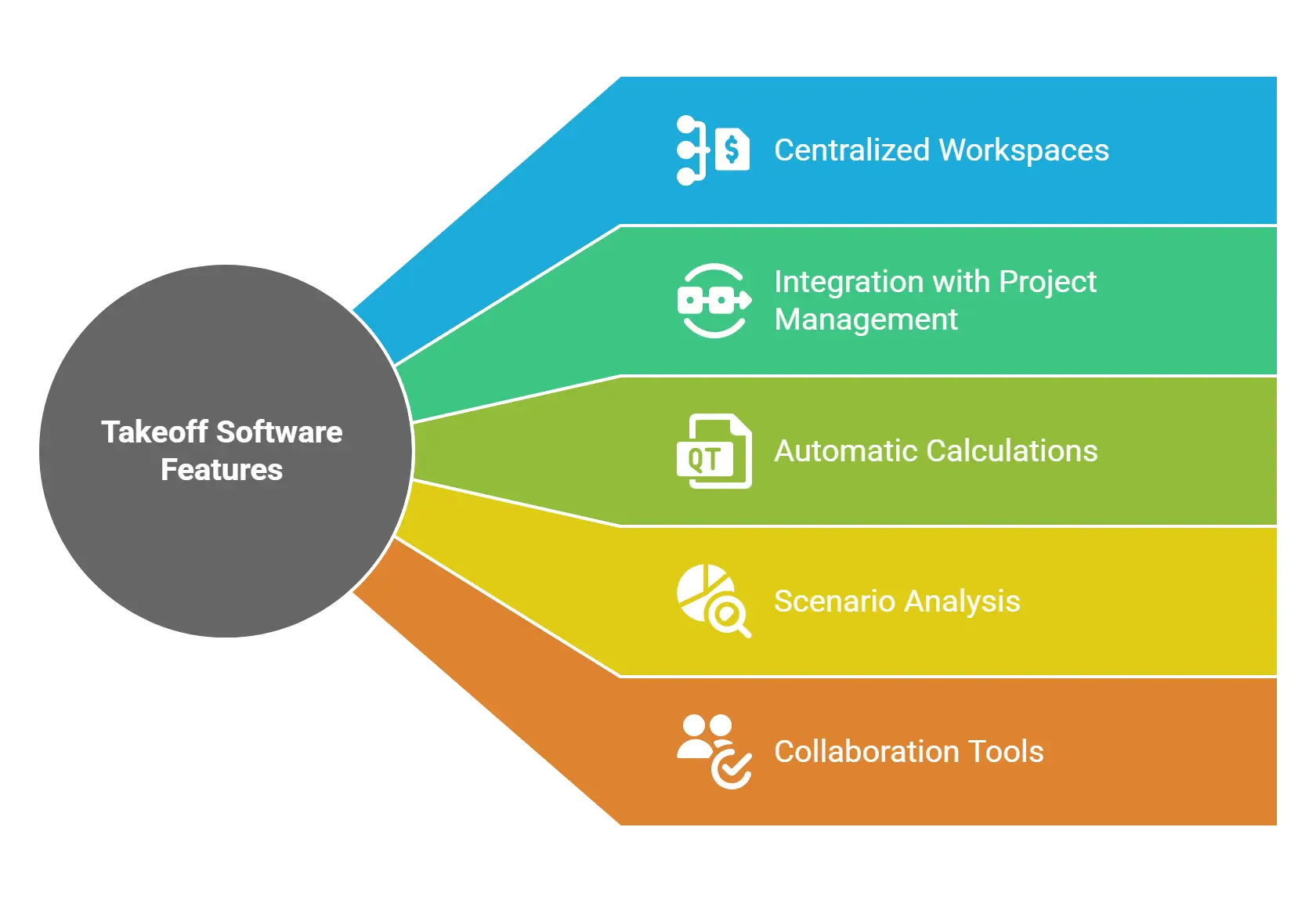
Frequently Asked Questions About Quantity Takeoff Construction
What is a quantity takeoff in construction?
A quantity takeoff is a systematic process that measures and lists all materials, labor, and resources a construction project will need. The data comes directly from the project’s drawings and specs and is used for construction estimating, cost estimation, and planning.
How does quantity takeoff improve project accuracy?
By measuring and documenting requirements precisely, quantity takeoff provides a strong base for cost estimation, purchasing, and scheduling. Getting this right means fewer budget overages, missing materials, material waste, or unplanned delays once work begins.
What is the difference between a quantity takeoff and a material takeoff?
A quantity takeoff covers the entire scope: materials, labor, equipment, and more. A material takeoff only counts up the materials, without accounting for labor hours or equipment needs.
Where does quantity takeoff fit into the construction workflow?
Quantity takeoff is used at every stage of the construction process: from early designs and budgeting, through procurement and scheduling, and all the way to final tracking. It’s the foundation of every budget, bid, and buying decision.
How can digital tools help with quantity takeoff?
Modern takeoff software and digital quantity takeoff platforms make measurement faster and more reliable, bringing material and labor data together in one place. Integrated with estimating and project management tools, these systems streamline workflows and help teams stay in sync from concept to closeout.
Ready to Improve Your Construction Takeoff Process?
If you're seeking to bring your construction estimating into the digital age, explore Nomitech’s full suite or reach out to their team to find the right digital quantity takeoff solution for your workflow.
Whether you’re managing a simple building project or tackling complex projects with multiple stakeholders, mastering quantity takeoff construction ensures your estimates, budgets, and schedules are grounded in reality, giving your construction project every chance for success.




